Measuring Activities of Daily Living in Stroke Patients with Motion Machine Learning Algorithms: A Pilot Study
Abstract
1. Introduction
2. Materials and Methods
2.1. Participants
2.2. Procedures
2.3. Data Analysis
2.4. Classified Model Development
3. Results
3.1. Characteristics of Study Participants
3.2. Data Extraction and Model Development
4. Discussion
5. Conclusions
Author Contributions
Funding
Institutional Review Board Statement
Informed Consent Statement
Data Availability Statement
Acknowledgments
Conflicts of Interest
Appendix A
| Variables | Variable Names | Descriptions |
|---|---|---|
| 1 | l1.acc.x | Left Wrist, Accelerometer, X-axis |
| 2 | l1.acc.y | Left Wrist, Accelerometer, Y-axis |
| 3 | l1.acc.z | Left Wrist, Accelerometer, Z-axis |
| 4 | l1.gyr.x | Left Wrist, Gyroscope, X-axis |
| 5 | l1.gyr.y | Left Wrist, Gyroscope, Y-axis |
| 6 | l1.gyr.z | Left Wrist, Gyroscope, Z-axis |
| 7 | l2.acc.x | Left Arm, Accelerometer, X-axis |
| 8 | l2.acc.y | Left Arm, Accelerometer, Y-axis |
| 9 | l2.acc.z | Left Arm, Accelerometer, Z-axis |
| 10 | l2.gyr.x | Left Arm, Gyroscope, X-axis |
| 11 | l2.gyr.y | Left Arm, Gyroscope, Y-axis |
| 12 | l2.gyr.z | Left Arm, Gyroscope, Z-axis |
| 13 | r1.acc.x | Right Wrist, Accelerometer, X-axis |
| 14 | r1.acc.y | Right Wrist, Accelerometer, Y-axis |
| 15 | r1.acc.z | Right Wrist, Accelerometer, Z-axis |
| 16 | r1.gyr.x | Right Wrist, Gyroscope, X-axis |
| 17 | r1.gyr.y | Right Wrist, Gyroscope, Y-axis |
| 18 | r1.gyr.z | Right Wrist, Gyroscope, Z-axis |
| 19 | r2.acc.x | Right Arm, Accelerometer, X-axis |
| 20 | r2.acc.y | Right Arm, Accelerometer, Y-axis |
| 21 | r2.acc.z | Right Arm, Accelerometer, Z-axis |
| 22 | r2.gyr.x | Right Arm, Gyroscope, X-axis |
| 23 | r2.gyr.y | Right Arm, Gyroscope, Y-axis |
| 24 | r2.gyr.z | Right Arm, Gyroscope, Z-axis |
| 25 | b.acc.x | Hip, Accelerometer, X-axis |
| 26 | b.acc.y | Hip, Accelerometer, Y-axis |
| 27 | b.acc.z | Hip, Accelerometer, Z-axis |
| 28 | b.gyr.x | Hip, Gyroscope, X-axis |
| 29 | b.gyr.y | Hip, Gyroscope, Y-axis |
| 30 | b.gyr.z | Hip, Gyroscope, Z-axis |
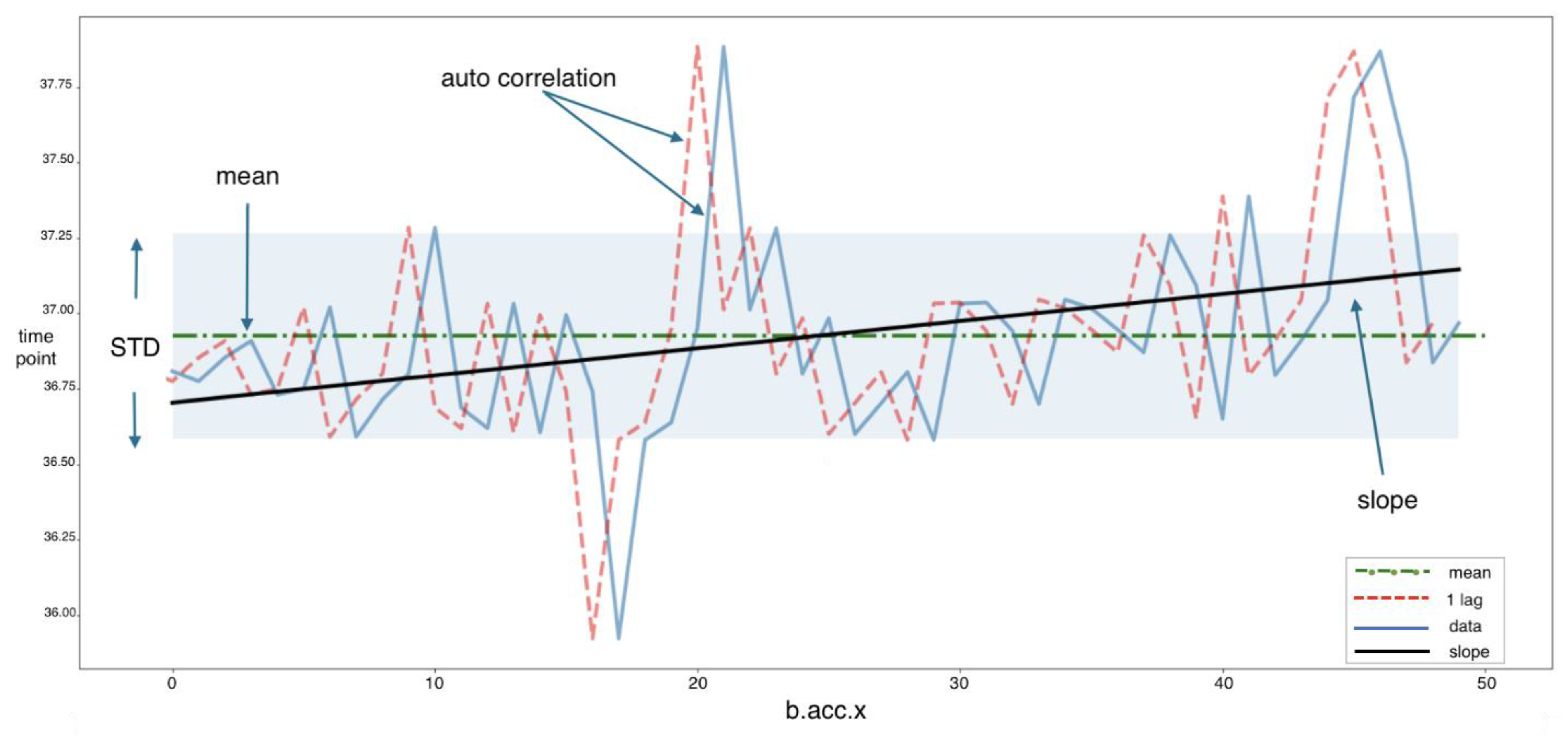
Appendix B
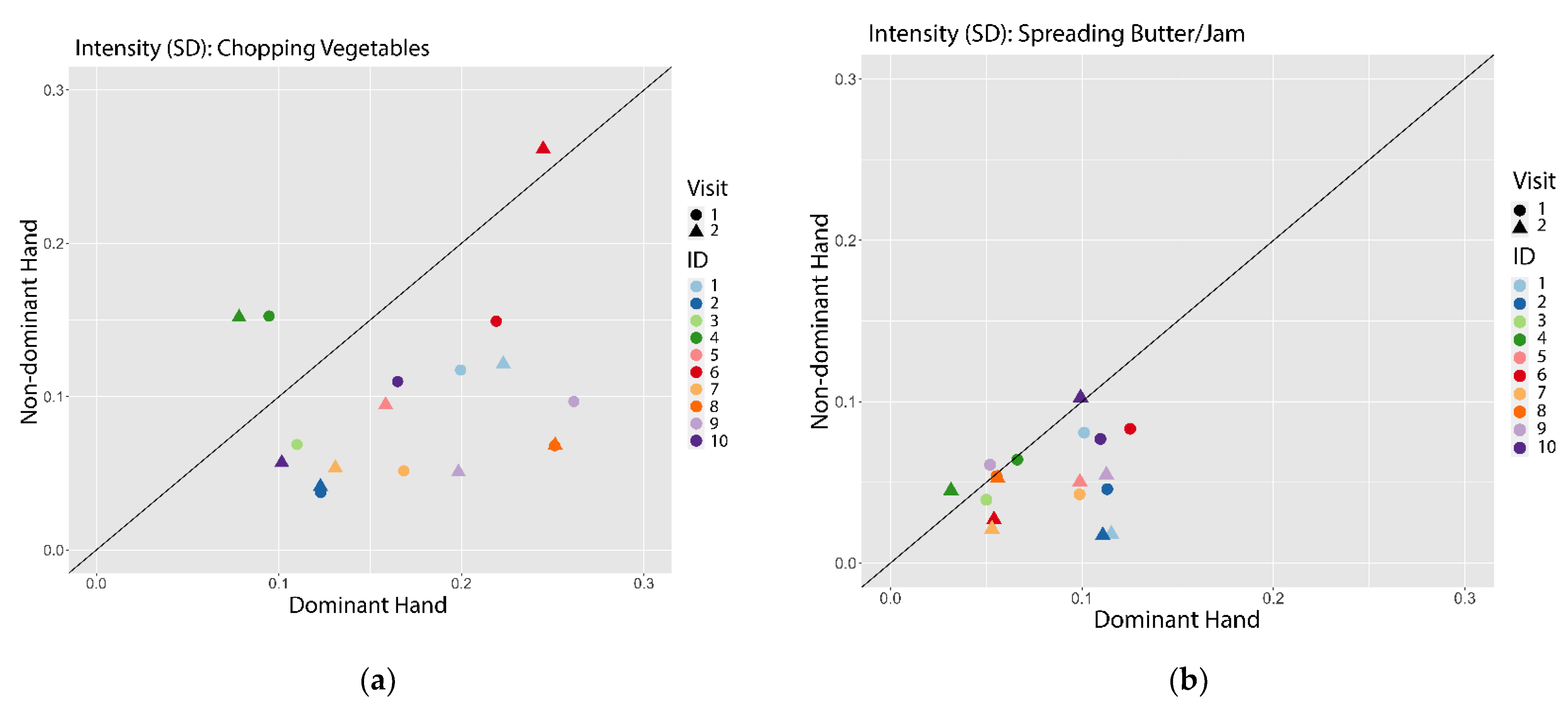
References
- Virani, S.S.; Alonso, A.; Benjamin, E.J.; Bittencourt, M.S.; Callaway, C.W.; Carson, A.P.; Chamberlain, A.M.; Chang, A.R.; Cheng, S.; Delling, F.N.; et al. Heart Disease and Stroke Statistics—2020 Update: A Report from the American Heart Association. Circulation 2020, 141, e139–e596. [Google Scholar] [CrossRef]
- Shamay, N.S.; William, T.W.; Patrick, K.W.; Philip, T.T.; Jefferry, W.C. Sensorimotor impairments of paretic upper limb correlates with activities of daily living in subjects with chronic stroke. S. Afr. J. Physiother. 2011, 67, 9–16. [Google Scholar] [CrossRef]
- Crichton, S.L.; Bray, B.D.; McKevitt, C.; Rudd, A.G.; Wolfe, C.D. Patient outcomes up to 15 years after stroke: Survival, disability, quality of life, cognition and mental health. J. Neurol. Neurosurg. Psychiatry 2016, 87, 1091–1098. [Google Scholar] [CrossRef] [PubMed]
- Mayo, N.E.; Wood-Dauphinee, S.; Côté, R.; Durcan, L.; Carlton, J. Activity, participation, and quality of life 6 months poststroke. Arch. Phys. Med. Rehabil. 2002, 83, 1035–1042. [Google Scholar] [CrossRef] [PubMed]
- Mast, B.T.; Azar, A.R.; MacNeill, S.E.; Lichtenberg, P.A. Depression and Activities of Daily Living Predict Rehospitalization within 6 Months of Discharge From Geriatric Rehabilitation. Rehabil. Psychol. 2004, 49, 219. [Google Scholar] [CrossRef]
- Sager, M.A.; Franke, T.; Inouye, S.K.; Landefeld, C.S.; Morgan, T.M.; Rudberg, M.A.; Sebens, H.; Winograd, C.H. Functional outcomes of acute medical illness and hospitalization in older persons. Arch. Intern. Med. 1996, 156, 645–652. [Google Scholar] [CrossRef]
- Cain, A.E.; Depp, C.A.; Jeste, D.V. Ecological momentary assessment in aging research: A critical review. J. Psychiatr. Res. 2009, 43, 987–996. [Google Scholar] [CrossRef] [PubMed]
- Troiano, R.P.; Berrigan, D.; Dodd, K.W.; Mâsse, L.C.; Tilert, T.; McDowell, M. Physical activity in the United States measured by accelerometer. Med. Sci. Sports Exerc. 2008, 40, 181–188. [Google Scholar] [CrossRef] [PubMed]
- Trull, T.J.; Ebner-Priemer, U. Ambulatory assessment. Annu. Rev. Clin. Psychol. 2013, 9, 151–176. [Google Scholar] [CrossRef]
- Magaziner, J.; Simonsick, E.M.; Kashner, T.M.; Hebel, J.R. Patient-proxy response comparability on measures of patient health and functional status. J. Clin. Epidemiol. 1988, 41, 1065–1074. [Google Scholar] [CrossRef]
- Rubenstein, L.Z.; Schairer, C.; Wieland, G.D.; Kane, R. Systematic biases in functional status assessment of elderly adults: Effects of different data sources. J. Gerontol. 1984, 39, 686–691. [Google Scholar] [CrossRef] [PubMed]
- Galperin, I.; Hillel, I.; Del Din, S.; Bekkers, E.M.J.; Nieuwboer, A.; Abbruzzese, G.; Avanzino, L.; Nieuwhof, F.; Bloem, B.R.; Rochester, L.; et al. Associations between daily-living physical activity and laboratory-based assessments of motor severity in patients with falls and Parkinson’s disease. Parkinsonism Relat. Disord. 2019, 62, 85–90. [Google Scholar] [CrossRef] [PubMed]
- Sim, I. Mobile Devices and Health. N. Engl. J. Med. 2019, 381, 956–968. [Google Scholar] [CrossRef] [PubMed]
- Aggarwal, J.K.; Xia, L. Human activity recognition from 3d data: A review. Pattern Recognit. Lett. 2014, 48, 70–80. [Google Scholar] [CrossRef]
- Babiker, M.; Khalifa, O.O.; Htike, K.K.; Hassan, A.; Zaharadeen, M. Automated daily human activity recognition for video surveillance using neural network. In Proceedings of the 2017 IEEE 4th International Conference on Smart Instrumentation, Measurement and Application (ICSIMA), Putrajaya, Malaysia, 28–30 November 2017; pp. 1–5. [Google Scholar]
- Zhang, S.; Wei, Z.; Nie, J.; Huang, L.; Wang, S.; Li, Z. A Review on Human Activity Recognition Using Vision-Based Method. J. Healthc. Eng. 2017, 2017, 3090343. [Google Scholar] [CrossRef]
- Ranasinghe, S.; Al Machot, F.; Mayr, H.C. A review on applications of activity recognition systems with regard to performance and evaluation. Int. J. Distrib. Sens. Netw. 2016, 12, 1550147716665520. [Google Scholar] [CrossRef]
- Bao, L.; Intille, S.S. Activity recognition from user-annotated acceleration data. In International Conference on Pervasive Computing; Springer: Berlin/Heidelberg, Germany, 2004; pp. 1–17. [Google Scholar]
- Nweke, H.F.; Teh, Y.W.; Mujtaba, G.; Al-Garadi, M.A. Data fusion and multiple classifier systems for human activity detection and health monitoring: Review and open research directions. Inf. Fusion 2019, 46, 147–170. [Google Scholar] [CrossRef]
- Twomey, N.; Diethe, T.; Fafoutis, X.; Elsts, A.; McConville, R.; Flach, P.; Craddock, I. A comprehensive study of activity recognition using accelerometers. Informatics 2018, 5, 27. [Google Scholar] [CrossRef]
- Wang, J.; Chen, Y.; Hao, S.; Peng, X.; Hu, L. Deep learning for sensor-based activity recognition: A survey. Pattern Recognit. Lett. 2019, 119, 3–11. [Google Scholar] [CrossRef]
- Lehman, L.H.; Mark, R.G.; Nemati, S. A Model-Based Machine Learning Approach to Probing Autonomic Regulation from Nonstationary Vital-Sign Time Series. IEEE J. Biomed. Health Inform. 2018, 22, 56–66. [Google Scholar] [CrossRef]
- Alghamdi, M.; Al-Mallah, M.; Keteyian, S.; Brawner, C.; Ehrman, J.; Sakr, S. Predicting diabetes mellitus using SMOTE and ensemble machine learning approach: The Henry Ford ExercIse Testing (FIT) project. PLoS ONE 2017, 12, e0179805. [Google Scholar] [CrossRef]
- Tan, X.; Su, S.; Huang, Z.; Guo, X.; Zuo, Z.; Sun, X.; Li, L. Wireless Sensor Networks Intrusion Detection Based on SMOTE and the Random Forest Algorithm. Sensors 2019, 19, 203. [Google Scholar] [CrossRef] [PubMed]
- Wang, Q.; Luo, Z.; Huang, J.; Feng, Y.; Liu, Z. A Novel Ensemble Method for Imbalanced Data Learning: Bagging of Extrapolation-SMOTE SVM. Comput. Intell. Neurosci. 2017, 2017, 1827016. [Google Scholar] [CrossRef] [PubMed]
- Lee, S.-I.; Lundberg, S.M. A unified approach to interpreting model predictions. In Advances in Neural Information Processing Systems 30; Guyon, I., Luxburg, U.V., Bengio, S., Wallach, H., Fergus, R., Vishwanathan, S., Garnett, R., Eds.; Curran Associates, Inc.: Long Beach, CA, USA, 2017; pp. 4765–4774. [Google Scholar]
- Lundberg, S.M.; Erion, G.; Chen, H.; DeGrave, A.; Prutkin, J.M.; Nair, B.; Katz, R.; Himmelfarb, J.; Bansal, N.; Lee, S.I. From Local Explanations to Global Understanding with Explainable AI for Trees. Nat. Mach. Intell. 2020, 2, 56–67. [Google Scholar] [CrossRef] [PubMed]
- Chen, T.; Guestrin, C. XGBoost: A Scalable Tree Boosting System. In Proceedings of the 22nd ACM Sigkdd International Conference on Knowledge Discovery and Data Mining, San Francisco, CA, USA, 13–17 August 2016; pp. 785–794. [Google Scholar]
- Hastie, T.; Tibshirani, R.; Friedman, J. The Elements of Statistical Learning: Data Mining, Inference, and Prediction, 2nd ed.; Springer: Stanford, CA, USA, 2009. [Google Scholar]
- Feurer, M.; Klein, A.; Eggensperger, K.; Springenberg, J.; Blum, M.; Hutter, F. Efficient and Robust Automated Machine Learning. In Advances in Neural Information Processing Systems 28; Cortes, C., Lawrence, N.D., Lee, D.D., Sugiyama, M., Garnett, R., Eds.; Curran Associates, Inc.: Montreal, QC, Canada, 2015; pp. 2962–2970. [Google Scholar]
- Bergstra, J.; Yamins, D.; Cox, D.D. Making a Science of Model Search: Hyperparameter Optimization in Hundreds of Dimensions for Vision Architectures. In Proceedings of the 30th International Conference on Machine Learning, Atlanta, GA, USA, 17–19 June 2013; Volume 28, pp. 115–123. [Google Scholar]
- Fernández, A.; García, S.; Galar, M.; Prati, R.C.; Krawczyk, B.; Herrera, F. Learning from Imbalanced Data Sets; Springer: Cham, Switzerland, 2018. [Google Scholar]
- Cheung, V.H.; Gray, L.; Karunanithi, M. Review of accelerometry for determining daily activity among elderly patients. Arch. Phys. Med. Rehabil. 2011, 92, 998–1014. [Google Scholar] [CrossRef] [PubMed]
- Capela, N.A.; Lemaire, E.D.; Baddour, N. Feature selection for wearable smartphone-based human activity recognition with able bodied, elderly, and stroke patients. PLoS ONE 2015, 10, e0124414. [Google Scholar] [CrossRef]
- Capela, N.A.; Lemaire, E.D.; Baddour, N.; Rudolf, M.; Goljar, N.; Burger, H. Evaluation of a smartphone human activity recognition application with able-bodied and stroke participants. J. Neuroeng. Rehabil. 2016, 13, 5. [Google Scholar] [CrossRef]
- Bailey, R.R.; Birkenmeier, R.L.; Lang, C.E. Real-world affected upper limb activity in chronic stroke: An examination of potential modifying factors. Top. Stroke Rehabil. 2015, 22, 26–33. [Google Scholar] [CrossRef]
- Lang, C.E.; Bland, M.D.; Bailey, R.R.; Schaefer, S.Y.; Birkenmeier, R.L. Assessment of upper extremity impairment, function, and activity after stroke: Foundations for clinical decision making. J. Hand Ther. 2013, 26, 104–114; quiz 115. [Google Scholar] [CrossRef]
- Bailey, R.R.; Klaesner, J.W.; Lang, C.E. An accelerometry-based methodology for assessment of real-world bilateral upper extremity activity. PLoS ONE 2014, 9, e103135. [Google Scholar] [CrossRef]
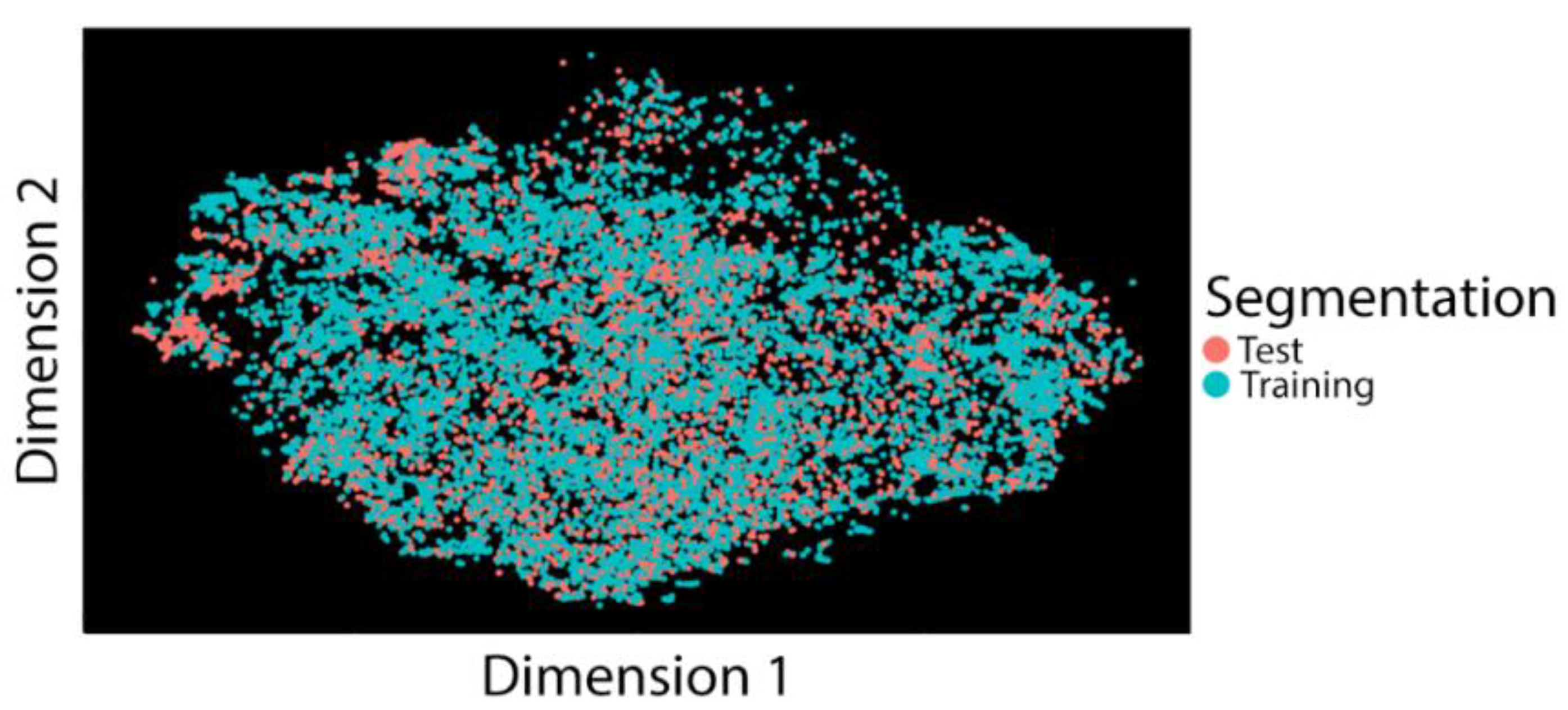

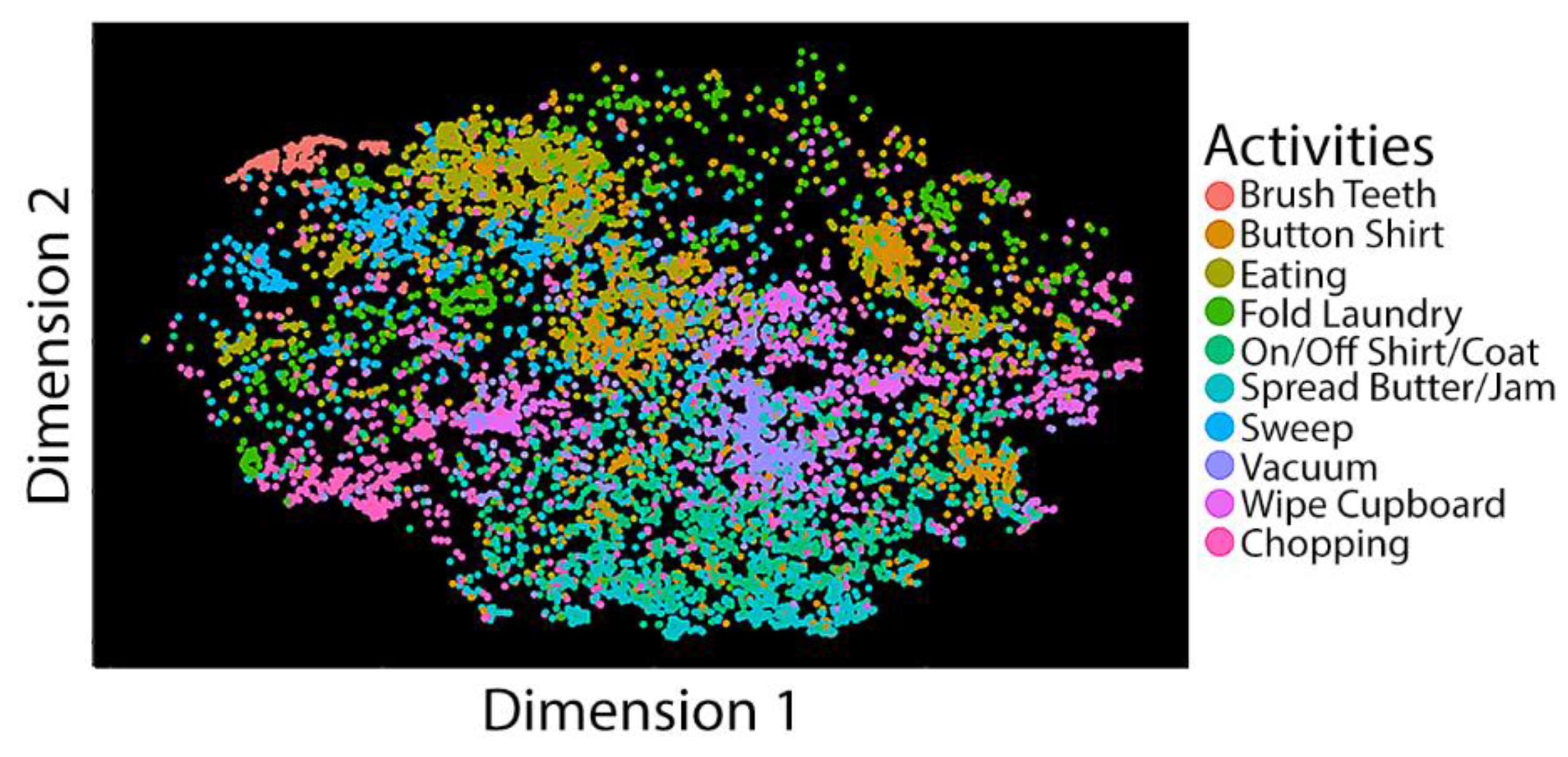
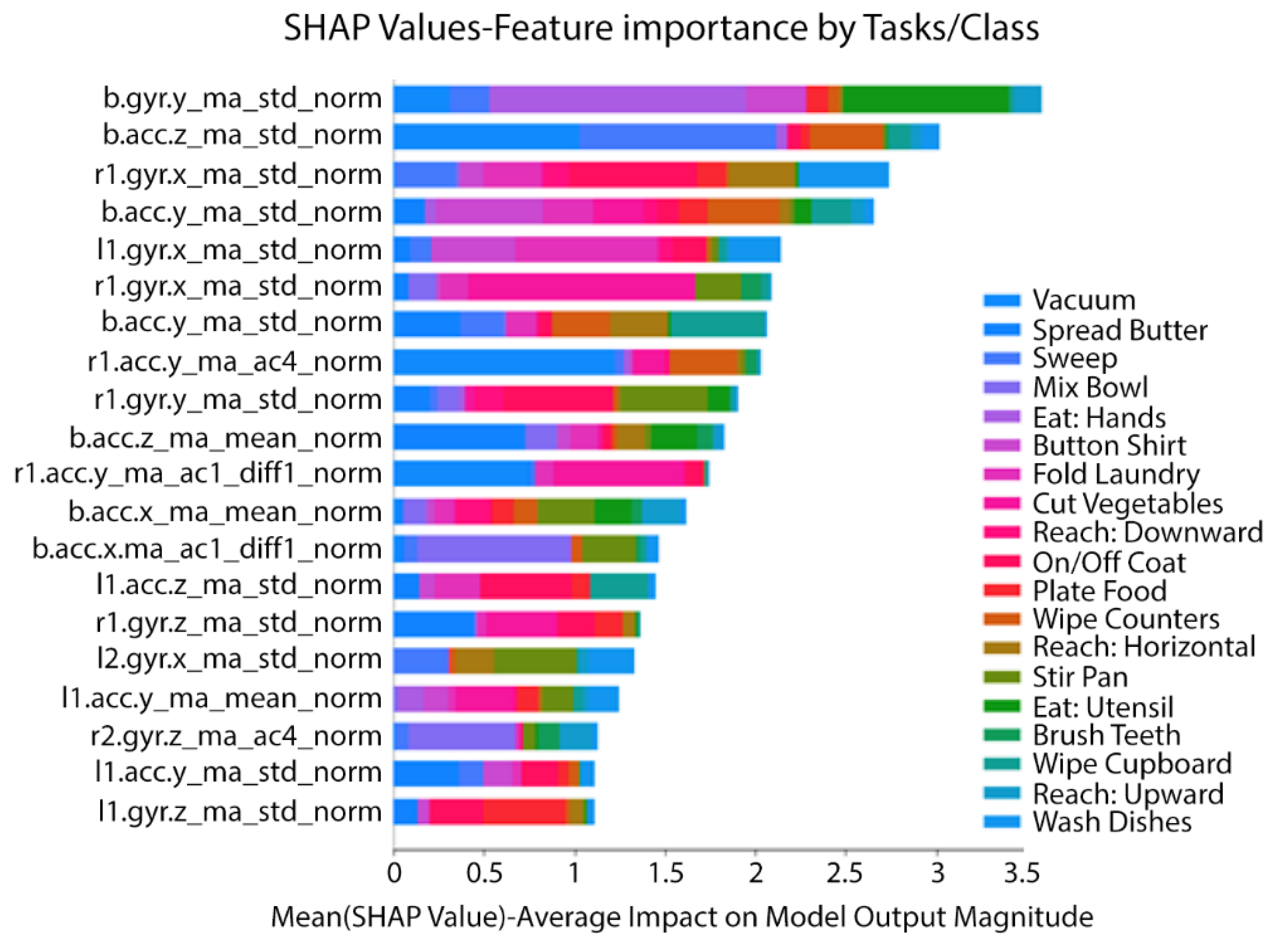
| Atomic Activities | ADL/IADL |
|---|---|
| Brush Teeth | ADL |
| Mixing Powders | IADL |
| Spreading Butter/Jam | IADL |
| Eating with Hands | ADL |
| Eating with Utensils | ADL |
| Buttoning shirt/coat | ADL |
| Put and take off the coat | ADL |
| Moving items horizontally | ADL |
| Reaching Up | ADL |
| Reaching Down | ADL |
| Washing Dishes | IADL |
| Chopping | IADL |
| Pan Stirring | IADL |
| Serve on a plate | IADL |
| Sweeping | IADL |
| Vacuuming | IADL |
| Wiping horizontal surface | IADL |
| Wiping vertical surface | IADL |
| Folding clothes | IADL |
| Characteristics | Mean (SD)/Count |
|---|---|
| Age | 59.64 (9.04) |
| Years since stroke | 2.76 (1.73) |
| NIHSS 1 Total Score | 1.45 (1.29) |
| Sex | 8 males; 3 females |
| Race | 6 Caucasian; 4 African American; 1 unknown |
| Education | 4 high school graduates; 5 some college; 2 bachelor’s degree |
| Handedness | 10 right; 1 left |
| Stroke Type | 11 ischemic; 0 hemorrhagic |
| Stroke Side | 6 right-hemispheric; 4 left-hemispheric; 1 unknown |
| Performance Metric 1 | Decision Tree | Random Forest | SVM | XGBoost |
|---|---|---|---|---|
| Training Set | ||||
| Accuracy | 0.56 | 0.79 | 0.97 | 0.97 |
| AUC | 0.74 | 0.88 | 0.99 | 0.98 |
| Precision | 0.50 | 0.80 | 0.97 | 0.97 |
| Recall | 0.56 | 0.79 | 0.97 | 0.97 |
| Test Set | ||||
| Accuracy | 0.43 | 0.80 | 0.90 | 0.90 |
| AUC | 0.68 | 0.89 | 0.95 | 0.98 |
| Precision | 0.47 | 0.84 | 0.92 | 0.83 |
| Recall | 0.43 | 0.80 | 0.90 | 0.91 |
Publisher’s Note: MDPI stays neutral with regard to jurisdictional claims in published maps and institutional affiliations. |
© 2021 by the authors. Licensee MDPI, Basel, Switzerland. This article is an open access article distributed under the terms and conditions of the Creative Commons Attribution (CC BY) license (http://creativecommons.org/licenses/by/4.0/).
Share and Cite
Chen, P.-W.; Baune, N.A.; Zwir, I.; Wang, J.; Swamidass, V.; Wong, A.W.K. Measuring Activities of Daily Living in Stroke Patients with Motion Machine Learning Algorithms: A Pilot Study. Int. J. Environ. Res. Public Health 2021, 18, 1634. https://doi.org/10.3390/ijerph18041634
Chen P-W, Baune NA, Zwir I, Wang J, Swamidass V, Wong AWK. Measuring Activities of Daily Living in Stroke Patients with Motion Machine Learning Algorithms: A Pilot Study. International Journal of Environmental Research and Public Health. 2021; 18(4):1634. https://doi.org/10.3390/ijerph18041634
Chicago/Turabian StyleChen, Pin-Wei, Nathan A. Baune, Igor Zwir, Jiayu Wang, Victoria Swamidass, and Alex W.K. Wong. 2021. "Measuring Activities of Daily Living in Stroke Patients with Motion Machine Learning Algorithms: A Pilot Study" International Journal of Environmental Research and Public Health 18, no. 4: 1634. https://doi.org/10.3390/ijerph18041634
APA StyleChen, P.-W., Baune, N. A., Zwir, I., Wang, J., Swamidass, V., & Wong, A. W. K. (2021). Measuring Activities of Daily Living in Stroke Patients with Motion Machine Learning Algorithms: A Pilot Study. International Journal of Environmental Research and Public Health, 18(4), 1634. https://doi.org/10.3390/ijerph18041634






